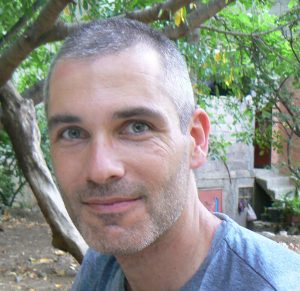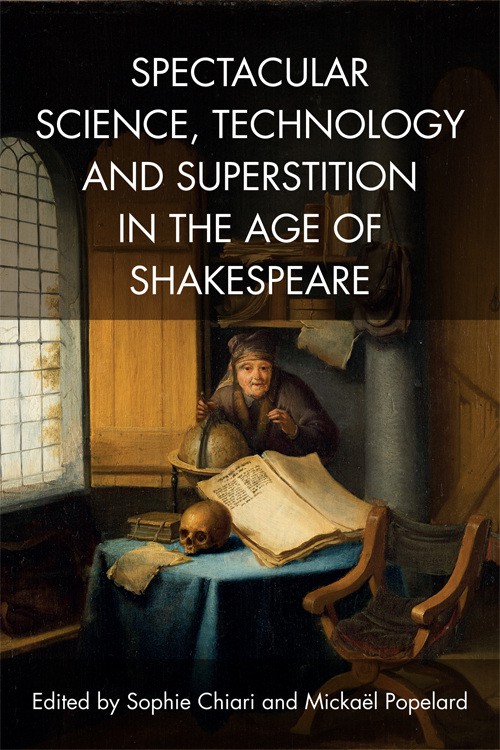
By Sophie Chiari and Mickaël Popelard
The second part of our quiz poses another 14 questions on Shakespeare and science. Missed the first part? Check it out here.
- How often does Shakespeare refer to atomism in his plays?
Page 123, Jonathan Pollock: “There are very few mentions of the Greek word atomos (Latin atomus) and its English equivalent in Shakespeare’s plays. The most widely known is Mercutio’s use of the word in his fanciful description of the fairies’ midwife, Queen Mab, whose coach is ‘Drawn with a team of little atomi’(Romeo and Juliet, 1.4.58). Given the immediate context, it would be more appropriate to speak of the atoms as animate mites, rather than as inanimate motes. In As You Like It, Celia tells Rosalind: ‘It is as easy to count atomies as to resolve the propositions of a lover’ (3.2.227–8). The technical name of the rhetorical figure employed here by Celia is adynaton (‘impossible’), for it is strictly impossible to count atoms, not only because they are infinitesimal in size, but also because they are infinite in number. This is why the word is almost always used in the plural. An apparent exception is to be found in 2Henry IV, when Mistress Quickly inveighs against the First Beadle, calling him ‘Thou atomy, thou!’ (5.4.29, my emphasis). However, she is not suggesting that he is as minute and insignificant as a single solitary atom, but that he is as thin and emaciated as a skeleton, or anatomy. Being illiterate, she has mistaken the prefix ana- for the infinite article: an-atomy.”
- Do you know who is in fact the “Noble philosopher” and the “good Athenian” designated by King Lear in act 3, scene 4?
Page 128, Jonathan Pollock: “The characters in King Lear are very far from having acquired that quietness of mind which the Epicureans called ‘ataraxia’. Rather, most are ‘minded like the weather, / Most unquietly’ (3.1.2–3). This does not stop Lear from addressing Poor Tom, Edgar’s mad beggar persona, as ‘Noble philosopher’ (3.4.168) and ‘good Athenian’ (3.4.176). Given Poor Tom’s way of life and near nakedness, most commentators assume that Lear is equating him with the ancient Greek Cynical philosophers, Diogenes or Crassus. However, De rerum natura also celebrates a Greek mortal, ‘Graius homo mortalis’, who dared oppose religious dogma; nothing stopped him, ‘neque fama deum nec fulmina nec minitanti / murmure compressit caelum’ (DRN, 1.66–8). Although he is left unnamed, the reference is clearly to Epicurus.”
- Do you know who did the first translation of Alhazen into Latin?
Page 137, Anne-Valérie Dulac: “The first translation of Alhazen into Latin has been argued to be the work of probably two individuals, one of them having been identified (if hypothetically) as Gerard of Cremona. This is discernible through the fact that although the first half or so of the manuscript was relatively faithful to the Arabic text, the remaining chapters may be deemed ‘a rather inept distillation of the Arabic original’ (Smith 1987: xiv).”
- How familiar are you with the leading optical theories of Shakespeare’s time? For example, could you explain the difference between “intromissionism” and “extramissionism”?
Page 139, Anne-Valérie Dulac: “What is most striking in this list is the encounter or confrontation of extramissionists (‘who attributed vision to rays emanating from the observer’s eye’; Lindberg 2002: 127) and intromissionists (who, following Aristotle, assigned ‘the cause of vision to intromitted rays, which pass from visible object to observer’s eye, where they stimulate the visual power’; ibid.). Alhazen’s synthesis combined the two leading contradictory optical options of the time, thus granting him a long-lasting scientific posterity:
- Do you know where Gemma Frisius’s map of the world was inserted from 1544 onwards?
Page 148, note, Frank Lestringant: “Finished as early as 1540 and inserted as a reduced and simplified version in the Cosmographia from 1544 onwards, Gemma Frisius’s Charta cosmographica was republished for more than forty years.”
- What is the intermediary work bridging the gap between the Encomium moriae and Montaigne’s “Of Cannibals”?
Page 159, Frank Lestringant: “Incidentally, between the Encomium moriae and Montaigne’s ‘Of Cannibals’, one intermediary work can be traced, namely La Pazzia (‘Folly’ in Italian), a work published in Venice in 1540 and translated into French twenty-six years later under the suggestive title of Les louanges de LA FOLIE, Traicté fort plaisant en forme de Paradoxe (The Praise of Folly: A Pleasant Treatise in the Form of a Paradox). This anonymous pamphlet has been attributed to Ascanio Persio or to Vianezio Albergati. Be that as it may, well before Montaigne, this treatise brought the naked peoples of the New World into the linguistic space of the declamation.”
- In his Brevis et admiranda descriptio regni Guianae (1599), from which Shakespeare drew to write The Tempest, Sir Walter Ralegh provided a description of “Blemmyes”. But who are they and what do they look like?
Page 165, Frank Lestringant: “In this regard, it is worth noting that, in England, belief in the geographical wonders inherited from antiquity and the Middle Ages had been holding firm ground for a longer period than anywhere else in Europe. For instance, Mandeville’s travels remained extremely popular until Shakespeare’s time, with the apparition of Richard Hakluyt’s 1589 Principall Navigations, edited in English, and Sir Walter Raleigh’s 1599 Brevis et admiranda descriptio regni Guianae, which still, at the very end of the sixteenth century, depicted Amazons with bows and arrows and offered side and back views of Blemmyes who had their faces on their chests. Engravings such as those illustrating Raleigh’s description of Guyana are probably the direct sources of Gonzalo’s allusion to men ‘[w]hose heads stood in their breasts’ (3.3.47).”
- What mythical figure does Bacon compare Nature to?
Page 179, Mickael Popelard: “In fact, Bacon does not seem to posit a definite end to the transformation of nature. In an enlightening passage from The Advancement of Learning (1605), Bacon compares nature to the mythical figure of Proteus, explaining that art helps to actualise nature’s virtual qualities by bringing out all its hidden facets:
For like as a man’s disposition is never well known till he be crossed, nor Proteus ever changed shapes till he was straitened and held fast; so the passages and variations of nature cannot appear so fully in the liberty of nature as in the trials and vexations of art. (Bacon 2000a: 65)
In other words, the scientist’s role is to interfere with the ‘free course’ of Nature so as to force her into all the shapes she is capable of assuming.”
- What famous English philosopher believed that immortality could be achieved through scientific progress?
Page 182, Mickael Popelard: “For the ultimate goal of the natural philosopher is to make human life not only better and more comfortable, but also longer and possibly eternal. In the Historia vitae et mortis, Bacon expresses his confidence that ‘anything which can be repaired without destroying the original whole, is, like the vestal flame, potentially eternal’ (Bacon 2007: 147). The human body, Bacon believes, is one such thing, and the Historia vitae abounds in examples of biblical or legendary figures who enjoyed exceptional longevity, such as the kings of Arcadia who lived for 300 years or ‘a certain Dando in Illyria who lived for 500 years with none of the ailments of age’ (Bacon 2007: 213)”
- What (rather fanciful) explanation does Francis Bacon provide for the fact that old lions are often toothless?
Page 182, Mickael Popelard: “Bacon’s treatise is not entirely devoid of fanciful theories: setting out to correct the popular misconception that lions are long-lived because they are often toothless, he explains instead that leonine toothlessness ‘could be caused by their rank breath’ (Bacon 2007: 179).”
- When was the first public clock built in London?
Page 199, Sophie Chiari: “The first public clock in England was built in London by Italian clockmakers and it was set on the great tower of Windsor Castle in 1353.”
- What did Nicholas Vallin build in 1598?
Page 213, Sophie Chiari: “In 1598, the Flemish clockmaker Nicholas Vallin, whose family resided in the Blackfriars, managed to build an extraordinary musical chamber clock, whose melodious sounds were produced by thirteen different bells. Up to this day, this is the earliest known surviving musical clock.”
- Why does Berowne compare women to German clocks in Love’s Labour’s Lost?
Page 216, Sophie Chiari: “Each clock ran at its own rhythm, and this destroyed the idea of perfection, harmony and unity. One can therefore understand why, in Love’s Labour’s Lost, Berowne complains about women who, in his view, turn out to be as unreliable as German clocks (‘A woman, that is like a German clock, / Still a-repairing, ever out of frame, / And never going aright’; 3.1.185–7). If Berowne’s remark betrays his misogyny, he is nonetheless right in suggesting that an early modern watch needed to be constantly regulated and intensively scrutinised in order to work properly (Wilson 2014: 140).”
- Where does Guildenstern almost discover steam power?
Page 231, Liliane Campos: “Anachronism thus becomes a visual, rather than a textual, potential in Stoppard’s film [Rosencrantz and Guildenstern]. Many of the references to science, such as the wheels that ‘have been set in motion’ in Act 2, or the lines about the fixed star or relative movement of the sun and the earth in Act 3, are cut. But their effect is preserved, either by equivalent tropes – Guildenstern’s speech about wheels that have been set in motion is replaced by the Player’s lines from Hamlet describing the breaking wheel of Fortune – or by these visual scientific jokes which replace the textual hints at future discoveries with a comic routine, underlining our privileged position as spectators who know more than Rosencrantz. While he almost discovers steam power at the beginning of Act 2, Guildenstern remains oblivious, preoccupied by their previous conversation with Hamlet.”
Spectacular Science, Technology and Superstition in the Age of Shakespeare edited by Sophie Chiari and Mickaël Popelard publishes September 2017.
 Sophie Chiari is Professor of Early Modern English Literature at Clermont Auvergne University, France. She has written several books and articles on Shakespeare and his contemporaries. Her most recent publication is As You Like It: Shakespeare’s Comedy of Liberty (2016).
Sophie Chiari is Professor of Early Modern English Literature at Clermont Auvergne University, France. She has written several books and articles on Shakespeare and his contemporaries. Her most recent publication is As You Like It: Shakespeare’s Comedy of Liberty (2016).
 Mickaël Popelard is Senior Lecturer in English studies at the University of Caen Normandie, France. He has written several articles on Shakespeare and Bacon, as well as a book on the figure of the scientist in Shakespeare’s The Tempest and Marlowe’s Doctor Faustus (Rêves de puissance et ruine de l’âme: la figure du savant chez Shakespeare et Marlowe, 2010).
Mickaël Popelard is Senior Lecturer in English studies at the University of Caen Normandie, France. He has written several articles on Shakespeare and Bacon, as well as a book on the figure of the scientist in Shakespeare’s The Tempest and Marlowe’s Doctor Faustus (Rêves de puissance et ruine de l’âme: la figure du savant chez Shakespeare et Marlowe, 2010).





